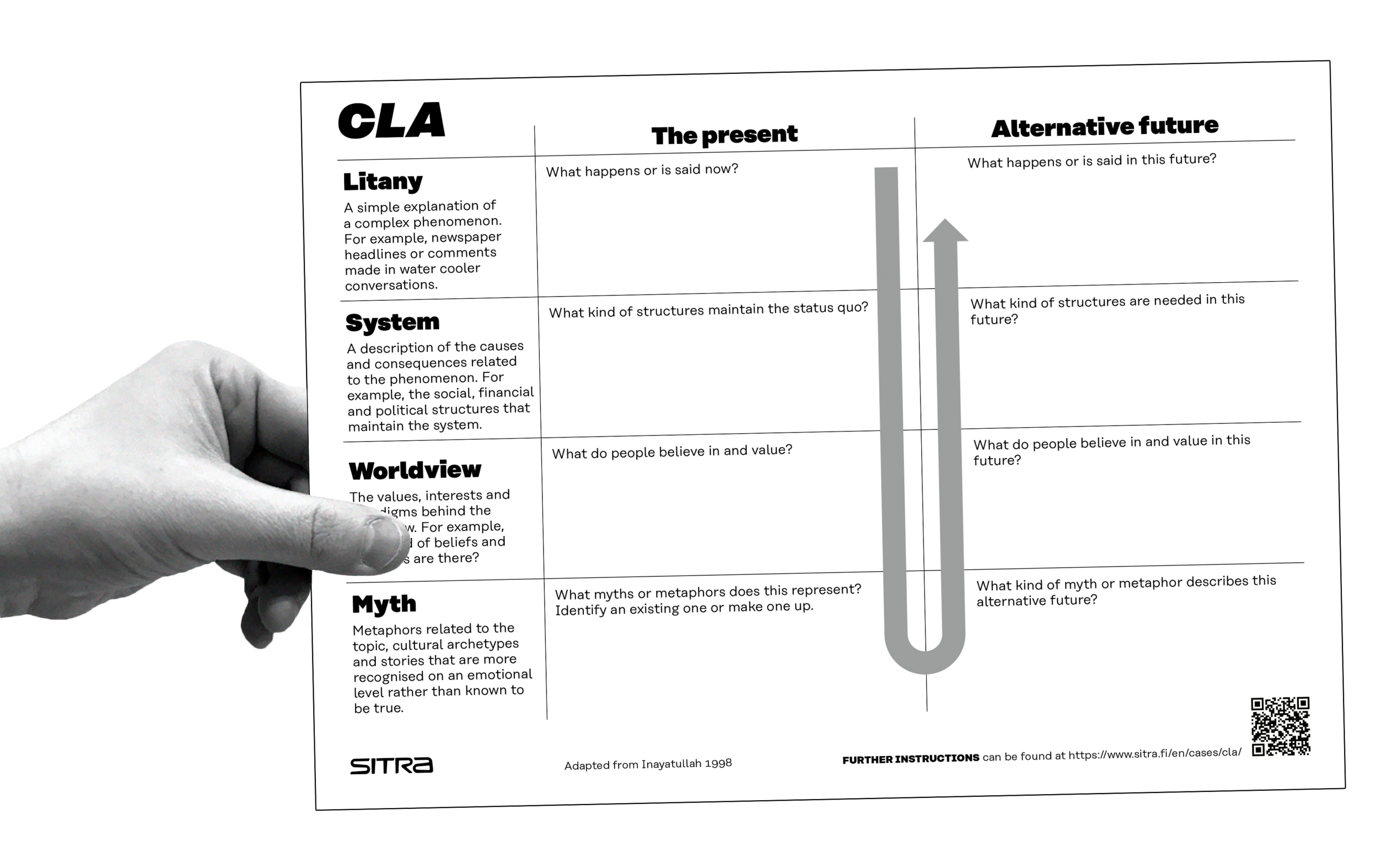Future trajectories involve many assumptions of what the world will actually be like. The future exists in the present in the form of various predictions, fears, wishes and goals – a sort of future imagery. But we rarely reflect on the kind of worldviews or beliefs that lie behind these assumptions about the future.
CLA helps challenge our own or a community’s thinking, while simultaneously creating space for alternative futures. CLA is an example of narrative forecasting. According to the futures studies researcher Sohail Inayatullah (1998), the developer of CLA, the method broadens our thinking about the present and the past to create alternative futures. The method is especially useful when the participants are willing to delve into what they think about the future of the topic at hand – even unconsciously. CLA can be helpful at the beginning of a broader process, such as strategy work.
Preparation
Decide on the subject you will be working on, meaning on what topic you want to challenge your thinking and about which you want to create a description of an alternative future.
Print out the worksheet or prepare a digital one.
Working
The work proceeds according to the worksheet from the left to the right. On the left side, the participants first consider the current state of the chosen topic, starting from the top down, from the surface level towards the myth. The idea is to identify facts and assumptions related to the current situation. Participants then move to the right side of the worksheet, moving from the bottom up. Now, the aim is to create a description of an alternative future on the same topic.
- Surface level (litany): a generalisation that simplifies the phenomenon. For example, if the topic is technological development, the description of the surface level could be “technology saves” or “technology solves the problems of our time”
- System: a description of the causes and consequences of a phenomenon, such as the social, financial and political structures that sustain the system. Following the example of technological development, the system could comprise investments and tax breaks for research and development or teaching in the technology sector.
- Worldview: What values, interests and paradigms maintain the system? To continue with the previous example, the worldview could be technology-optimistic, even techno-utopian in which technological development is thought to lead to the production of well-being for all. Other values that define the worldview could include speed and efficiency.
- Myth: Metaphors related to the subject, cultural archetypes and narratives that are identified emotionally rather than being known to be true. In the example of the future of technology, the metaphor could be a “cornucopia”. A narrative of technology constantly creating more well-being.
After the first phase, when the participants move on to challenge their assumptions, the topic will be deconstructed from the bottom up, to create an alternative description of the future. At the level of myth, the aim is to find new narratives, thought patterns and metaphors. Changing the worldview helps identify opportunities beyond current thinking. On the systemic level, you should aim to identify leverage points, while the surface level or litany points to simplifications of the topic. At this point the facilitator needs to ensure that the participants’ focus remains clear, meaning that they are working on the future of the same issue at every stage.
- Myth: What myth or metaphor describes this alternative future? Using the previous example, the metaphor could be one of technology being a good servant but a bad master.
- Worldview: What do people believe in and value in this future? What worldview does the myth or metaphor represent? For example, the worldview could emphasise a balance between technology, nature and humanity, with the aim of obtaining an overview and understanding the limitations of technology. Values such as humanism and responsibility could be emphasised.
- System: What kind of structures are needed in this future? What is a system pursuant to the new worldview? In the example, the system could be described as one in which economic incentives are directed towards addressing ethical, social and ecological issues in technological development. Skills development would emphasise comprehensive Bildung.
- Surface level: What will happen or be said in this future? What image of the future emerges from the above mentioned factors? The surface level description could look something like this: Changes in people’s actions, not technology, will solve the problems of our time.
Finally, think about what worldviews or beliefs you identified and how justified they are. How did a new myth or metaphor change the outlook on the future?
Tips
- You can write several things on each level of the worksheet, as this can enrich the shared view of both prevailing assumptions and of alternative ways of framing the topic, and thereby the future.
- When working on the left half of the worksheet, it is important to note that it does not only concern how you should think about the world, but reveals how the prevailing thinking and contemporary society are constructed. Sometimes, simply making this left side visible can be valuable even without working on the right side.
- It is a good idea to determine in advance what the work will and will not produce. Most of the time, the expansion of thinking brought on by CLA work is valuable in itself and creates a basis for thinking and work after applying CLA.
- It can often be challenging to consider the bottom layer of CLA – myths and metaphors. It can help the work if the facilitator collects a few examples in advance to give concrete examples of what myths and metaphors can mean.
Materials
- Worksheet: CLA (pdf)
- Worksheet filled in with examples (pdf)
Further reading
- The tool is based on Causal Layered Analysis (CLA; see Inayatullah 1998).
- An article on CLA by Hanna-Kaisa Aalto (in Finnish)
